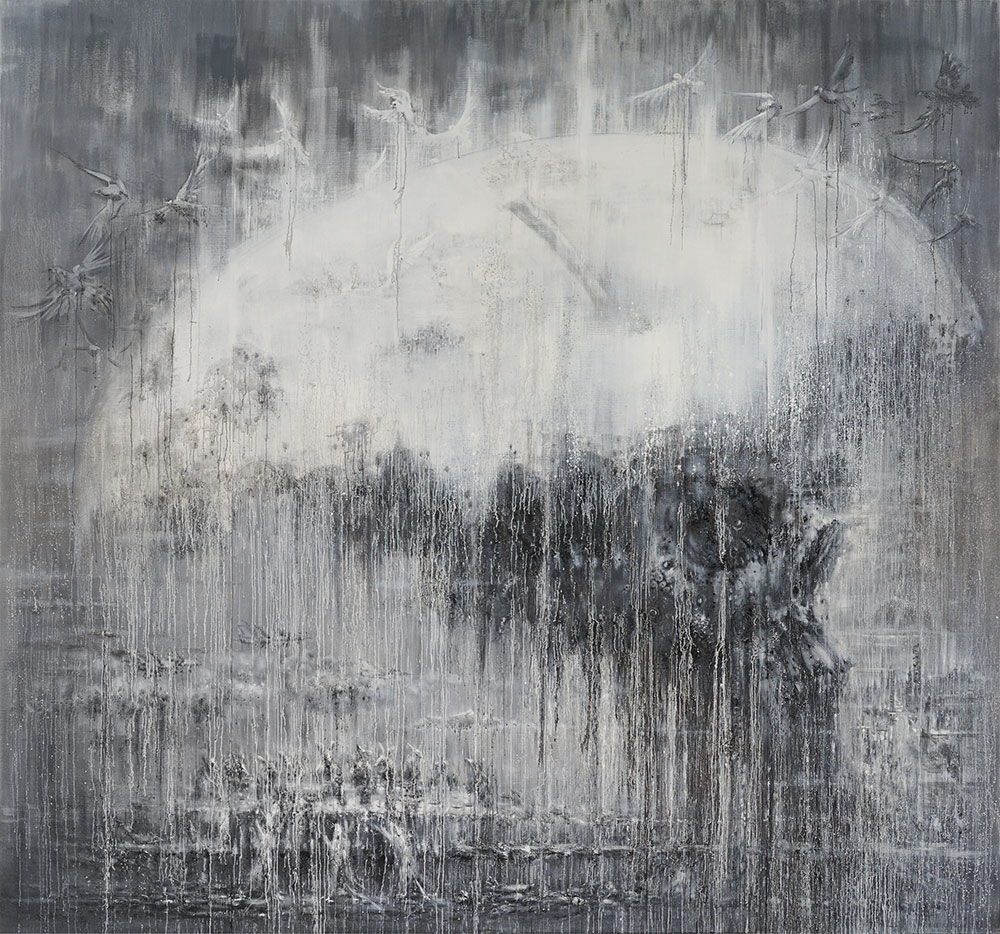孟巖的繪畫,當代之中古意氤氳。所謂“古意”,我并非指其“老式”。相反,他的創作超越任何“式”,試圖尋找一種不論在當代、還是過去或未來都雋永而本真的東西。要捕捉到這種飄忽的特質絕非易事;當然,也非所有畫家都能企及。
本次展出的作品分為三大系列,特色鮮明,又交相輝映。宏大主題、巨幅尺寸,畫作的分量感沖擊著我們的視覺感受和智覺感受。換言之,這些絕不是“輕松的”作品。而這種氣場讓觀者有時難以進入作品。孟巖的每一幅繪畫都堪稱一部創作史:顏料的材質感、厚重感和紋理感直白袒露,畫布上層層涂刷和刮擦的痕跡歷歷可見。
孟巖的作品非親見不能感受;隔著屏幕、甚至通過畫冊都難以呈現其面貌。因為,作品是有生命的,需要直面另一個生命體。慣性意味著畫家和繪畫的消亡。
在這篇短文中,我希望能開啟關于如何更好地直面這些畫作的對話。問題需要提出。當然,我無法保證給出任何答案。孟巖亦不能。問本身便是意義所在。好的藝術要求我們提出問題。正因如此,好的藝術才有意義。
繪畫的藝術亦是直面的藝術。對此,孟巖的理解可謂透徹。
肖像畫往往占據著室內最顯著的位置。其所表現的人物多已作古,這就要求我們直面終將來臨的死亡。在這個意義上,它們所表現的其實是蕓蕓眾生相。如果真有孟巖所謂“刮骨”之法能夠深入畫中人物腦海內一窺,我會建議大家也去刮開他的、以及我們自己的現實之“骨”。阿爾伯特·愛因斯坦、溫斯頓·丘吉爾、弗朗西斯·培根、薩爾瓦多·達利、安迪·沃霍爾、瑪麗蓮·夢露如何與我們的世界觀融為一體?這其中沒有單一的、一目了然的因果敘述,每個人對我們的社會文化場域都有著不可磨滅的影響。他們是無盡歷史矩陣中的一個個組成部分。我們無不如此。
所謂史詩更像是一頭狡黠的野獸。繪畫亦然,但卻有著持久留存的特點。
在《危機》系列中,孟巖將關注的目光投向超越個體之上的普世視角,在歷史與夢想之間上下求索,描繪出屬于這個時代的肖像。在他所有的作品中,不論在內容、尺幅還是體力消耗的維度上,這一系列都可謂最為宏大;過去十余年中他持續投入在《危機》系列的創作和精進中。多面龐然巨物承載著象征、歷史、焦灼,當然,也飽蘸顏料;德語中賦予這種體驗一個專有名詞—“狂飆突進”(Sturm und Drang);趨近黑暗浪漫主義,以主觀性和極端情緒作為對社會理性規范的回應,或曰解藥。
孟巖的作品中雖有宗教元素,但我們不應進而將他和他的作品歸為“宗教畫家”或“宗教繪畫”。相反,如20世紀現代主義藝術家柯林·麥卡宏(Colin McCahon)所言,宗教人物和敘事變成了一種速寫法,一種精神能指的集合,但從來不是作為某種容易的答案出現。
在《最后的晚餐》(2008-2016)中,(顯然取材自列奧納多·達·芬奇名作),置身于上空的耶穌和他的門徒們頭頂著光環,身無實形、體無實質,頭部和軀干部位顏料滴落,猶如鮮血流淌在塵世災難圖景之上。他們似乎在哭泣。或者,這是否在暗示無論是靈界還是塵世,面對人類對世界的摧殘與破壞,沒有任何一方能自居無辜?
某種程度上,《蘋果核》(2014-2018)在《危機》復雜的敘事和充滿象征意味的幻景、以及《活著》(2017-2018)的高度抽象之間搭起一座橋梁。在這幅作品中,伊甸園中象征基督教原罪的禁果,與愛因斯坦因對科學的盲目信仰而招致的原子彈蘑菇云夢魘結合在一起。能量的爆發、肌理的斷層,既是《雄心》、《欲望》、《危機之源》、《最后的晚餐》(均為2008-2016 的創作)中的反烏托邦的構成,也是其最終的歸宿。盡管如此,我并不認為孟巖是位悲觀主義者。極致的黑暗中孕育著巨大的光明。如果說《危機》(又名《危機之源》系列)是為社會可能發生的自我毀滅和貪癡所立的紀念碑,那么,作為其對立面的奇跡和超驗也必須存在。
孟巖的思想始終存在著某種互文性,能夠在東西兩種模式間輕松轉換,并讓人更多地感受到一種流動感,而非二元對立性。這是一場有無限切入點的雙重游戲。對于西方觀眾來說,羅蘭·巴特把“作者已死”和互文閱讀等批判思考引入公眾意識領域,讓讀者/觀者位于作品中心,而非處在敘事/繪畫之外。然而在中國詩畫中,活躍的讀者/觀者(activated reader/viewer) 這一概念本身就已經蘊含在作品之中,“游走式”的欣賞方式是水到渠成的,其在繪畫中常表現為三段式構圖,而在詩歌中則借助立體感極強的書法字體來實現。再加上古典詩歌的開放式句法,共同締造了臥游這一美學概念。從構圖和空間上來說,郭熙(1020-1090)的《早春圖》、董源(934-962)的《秋山問道圖》等經典名作之于《危機》中浮躁動蕩圖景的影響,就如同超現實主義之于薩爾瓦多·達利。
作為一名西方作者,很容易陷入對中國繪畫空間沉浸式表現的視而不見,而只對作品進行好與壞、天與地等簡單的二元解讀。只有對禪宗的因果輪回、易學、老莊思想有所了解,我們才能真正形成“大局觀”。每一處細節都令人著迷,每一個象征式人物背后都有一段故事;(不論透視還是觀念上)畫面并非遵循單一視角,沉浸于某種空無的豐盈,把自己完全交給這些鴻篇巨制所營造的充沛的深邃感,“萬物皆在其中,卻空如無物”,這不是更令人振奮嗎?
《活著》系列正是脫胎于這份深邃的內外。如果說《肖像》和《危機》系列體現了將過去和當下作為一個連續的整體來挖掘和呈現,那么《活著》則完全著眼于未來。以超越畫面之外的空間作為一切的源泉,孟巖很大程度上回避了過去數十載實踐中所形成的表現語言,將內在的錯綜與復雜掩映于外在的簡單之下。孟巖以油彩為媒,將傳統水墨的靈動、書法線條的優美、靜氣凝精與恣意揮灑、高亮的色調與晦暗的黑白融為一體,讓畫面在碰撞中交融。傳統的圖像/背景關系消融于畫面之中,幻化為純色、光影、能量和物質。
盡管作品洋溢著強烈的氣運感,但如果我們從美國抽象表現主義的角度來解讀他的作品,這無疑是錯誤的。孟巖的作品也不同于西方非寫實類的抽象——即僅僅將繪畫作為關系場域中的形式對象。我傾向于將其與二戰后崛起的新巴黎畫派和不定形藝術聯系起來。法國藝術家皮埃爾·蘇拉熱(Pierre Soulages)、喬治·馬修(Georges Mathieu)等人將集體烏托邦精神與抒情抽象和新實體主義相結合,隨后,趙無極、朱德群等一大批華裔藝術家加入他們的行列,體現了早期移居海外的華人藝術家嘗試與西方繪畫展開對話。孟巖的新作中有一些普世的元素可以視作向這批先驅藝術家的致敬。不過在抒情性之外,孟巖的創作手法中洋溢著一股迫切感和憤怒感,反差強烈的色調選擇在勾勒當下的同時,也揭示出某些尚未為人所見的東西。我把這些作品統稱為抽象,但事實上如此歸類似乎并不精確。孟巖為上述對話加入了新的內容;形式的痕跡、生命的訊息、成形乃至無形的人物紛紛在視網膜上飄忽而過。
放棄形式不等于忘記形式。在孟巖的世界里,我們看到一切皆有可能。
回到本次展覽的空間——嘉善博物館。孟巖別具匠心地把展廳分割為一個個“空間單元”。這本畫冊亦然。閑庭信步之間,觀者的感受與漫步于古典庭院又截然不同。觀眾可以自行選擇賞畫路徑,進退由心;我們會發現自己徜徉于思想的河流之中,所感遠超所見。
不同作品系列之間的區別是明顯的:《肖像》的栩栩如生,《危機》的宏篇巨幅和沉浸式的敘事氛圍,《活著》中極富爆發力的抒情唯物主義——孟巖似乎完全投身于對抽象的求索之中。
寫到這里,我想你已經明白在孟巖和他的藝術中,沒有田園牧歌,也沒有流行的裝飾元素。
孟巖的創作頻譜是激進的。作為觀眾,你也“被迫”要去直面、并最終擁抱這樣一種激進的觀看、欣賞和行動方式。空白畫布從不只是空白畫布。
這位藝術家從不只是一位畫家。
新西蘭/澳大利亞視覺藝術家和作家 克雷格·伊斯頓

蘋果核? Apple Core? 430x400cm? 2014-2018
Confronting Meng Yan
For all of his contemporaneity there is something ancient in the way Meng Yan approaches his painting practice. In using the word ‘ancient’ I don’t mean to say ‘old fashioned’. On the contrary it is to be without fashion, to search for something timeless and authentic to this present moment and all other moments, past and future. The capturing of such elusive things is not easy, and certainly not the preserve of just any painter.?
There are essentially three bodies of paintings in this carefully curated exhibition. They are distinct and yet entwined. These paintings in all their weight, scale and subject matter are frequently confronting to our visual sensibilities and our intellects. They are not ‘easy’ paintings. We do not so much absorb them as wrestle with their difficulties. A painting by Meng Yan wears its history of making: unashamed materiality, heaviness and texture of paint, the alternately caressing and attacking brush and scrapings of its strata.
These are paintings to be seen in the flesh, not on a screen, nor even in this book you are holding. That's because a painting is alive and needs to be confronted by another living being. Inertia is the death of painters and painting.
With this short essay I hope simply to start a conversation around how best to confront such paintings. Questions need to be asked. Yet I can’t promise any answers. And neither can Meng Yan. It’s the asking that matters. Good art asks that we ask. And for this reason good art matters.
The art of painting is also the art of confrontation. Meng Yan understands this better than most.
Portraits have a habit of dominating a room. In their raw state, and mostly of figures past, they require we confront our own mortality. They are after all drawn in our own image. If there is what Meng Yan calls a “scraping of the bones” to get inside the heads of those portrayed, I suggest we are also scraping the bones of his, and our own, realities. How do Albert Einstein, Winston Churchill, Francis Bacon, Salvador Dalí, Andy Warhol and Marilyn Monroe fit into our own worldview? There is no singular, immediately discernible narrative of cause-and-effect to be drawn, but for each person’s undeniable effect on our socio-cultural realms. They are pieces of an endless matrix of history. As are we all.
Historical fact is a slippery beast. Paint can be slippery too but has the advantage of staying where you stick it.
For the Crisis series Meng Yan moves definitively beyond the individual to the universal, scanning the horizon he reaches into history and his dreams, to render portraits of our times. Of all his endeavours this one is the grandest in content, scale and pure physical labour, producing and refining the Crisis paintings over the period of a decade. Great hulking multi-faceted things overloaded with the sheer weight of symbolism, history, personal angst and, of course, paint, they carry that thing the Germans speak of as “Sturm und Drang”; tending to a dark Romanticism with subjectivity and extreme emotions played out as reaction or antidote to society’s rationalist norms.?
Where religion appears in Meng Yan’s work we needn’t read it as marking these works out as ‘religious paintings’ or Meng Yan as a ‘religious artist’. Instead, as with the twentieth century modernist Colin McCahon, religion with its associated figures and narratives becomes a kind of shorthand, a collection of signifiers of the spiritual, but certainly never presented as easy answer.
In The Last Supper? (2008 - 2016), a clear reference to the famous Leonardo Da Vinci painting of the same name, Jesus and his Apostles are haloed figures floating disembodied, or disemboweled (?), head and torsos with paint dripping like so much blood upon the scenes of earthly destruction depicted below. Weeping they may be. Or could it be to suggest no power, spiritual or earthly, remains innocent of the devastation wreaked by man upon this world??
With Apple Core (2014 - 2018) I think we can discern something of a bridge between the complex narrative and symbol heavy dreamscapes of Crisis and the abstraction of the Alive works (2017 - 2018). In this one image we have the forbidden fruit of Christianity’s original sin in the Garden of Eden combining with the sin of the atomic mushroom cloud as the bad dream of Einstein’s blind faith to science. This burst of energy, this rupture in the fabric completing and answering the dystopias of The Ambition, The Lust, The Source of Crisis and The Last Supper (all 2008 – 2016). And yet, and yet…I do not choose to read Meng Yan as the great pessimist. Where there is great darkness there is also great light. If the Crisis works (also known as the Monumental series) are monuments to society’s potential for self-destruction, greed and stupidity, their opposites in the possibility of wonder and transcendence must also exist.
There is a constant inter-textual game at play in Meng Yan’s thinking that includes an easy slippage between Eastern and Western modes, illustrative less of binaries and more of fluidity.
This is a double game with endless points of entry. For Western audiences Roland Barthes may have helped bring to public consciousness critical ideas around ‘the death of the author’ and inter-textual reading, whereby the reader/viewer rather than external to the narrative/painting is placed centrally ‘in’ the work. But in both Chinese painting and poetry the notion of an activated reader/viewer located within the work and thus encouraged to take a wandering view is a natural one, expressed through techniques including the three-distance method and in poetry the almost three-dimensional aspect of the calligraphic character. This, alongside the open syntax of classical poetry, contributes to this idea of the wandering mind and spirit. Compositionally and spatially a painting like Spring Morning by Guo Xi (1020 - 1090) or Taoist Temple in the Mountains by Dong Yuan (934 - 962), in all its beauty, is arguably as essential to the troubled floating realms of the Crisis paintings as anything from the Surrealism of Salvador Dalí.?
As a Western writer it is all too easy to gloss over the immersive intent of the Chinese approach to painted space, and equally to read these paintings as a simplified two-term analysis between good and evil or heaven and earth. Instead it makes sense to also draw upon the karmic cycles of Chan Buddhism, and the forever changing Tao and teachings of Laozi, so that we are indeed dealing with the whole of the undifferentiated Fount . Each detail fascinates the eye, each symbolic figure offers a possible story, but instead of following the single perspective (optically or conceptually) is it not more exciting to give ourselves over to the empty fullness, the ‘everything and nothing’ of these vast paintings as both surface and bottomless depth??
It is from within and out of this depth that Meng Yan’s Alive paintings emerge. Where the Portraits and Crisis series have in part been an attempt at mining and representing both history and the present as contiguous states, Alive has its sights firmly on the future. Recognising the space beyond the image as the Fount from which all else appears, Meng Yan largely sidesteps the powerful representational languages developed over decades of practice to pull astounding complexity from apparent simplicity. Still working in oils he fuses the fluidity of traditional ink, the beauty of the calligraphic line, directional and chance gestures, use of high-key pigments and monochrome palettes, developing both scaffold and dissolution on/in/out of the one surface. Normative figure ground relationships dissolve into paintings remade as pure colour, light, energy and matter.?
Whilst heavily imprinted with the gestural, it would be misleading to fixate on the heroic individualism of American Abstract Expressionism in considering these paintings. Neither is it in the abstraction of the Western Non-objective model – an art focusing on the painting simply as a formal object in its own field of relations. Instead I would look to the post-Second World War rise of the New School of Paris and Art Informel. Marrying a collective utopian spirit with new combinations of Lyrical Abstraction and Neo Concretism, French artists Pierre Soulages and Georges Mathieu were joined by a wide array of international artists including Zhao Wuji and Zhu Dequn, representing Chinese modernism’s early émigré forays into Western painting dialogues. There is something in the universalism of Meng Yan’s new works that pays an elegant debt to these men. But where those artists’ lyricism prevailed, there is an urgency and fury to Meng Yan’s method, and a wildly contrasting, sometimes electrified colour palette that manages to be both of our contemporary moment and still offer something as yet unseen. I have written of these works as being abstract, but in truth it is an uneasy alliance. Meng Yan brilliantly contributes to the discourse; while all the time hints of form, signs of life, figures in the act of becoming and unbecoming flit across the retina.?
Letting go of form is not the same as forgetting form. In Meng Yan’s universe we learn everything is possible.
Returning to this space, here/now, in Jiashan Museum, Meng Yan has opted for a careful dividing up of the gallery into a series of ‘space cells’. This catalogue does something similar. And so you are free to meander contained/uncontained in a way not so unlike a stroll in an ancient literati garden. Able to choose our own path through the paintings, to push ahead or to double back, we find ourselves swimming in a flow of ideas that I hope by now you accept reaches well beyond the visual.?
There are clear differences in the bodies of work: the remarkable verisimilitudes of the Portraits, the monumentalism of scale and immersive story telling of Crisis, and the explosive lyrical materialism of the Alive series - in which Meng Yan seemingly gives himself over to the abstract impulse.
I expect by now you will have realised when you choose to follow Meng Yan and his art there is no chance of a polite invitation into an idyllic landscape, or even an offer of fashionable decoration.?
Meng Yan embraces a radical spectrum of making. And you in turn as viewer are ‘made’ to confront, and ultimately embrace, a radical way of looking, seeing and doing. The blank canvas is never just a blank canvas.
The artist is never just a painter.
Craig Easton?






 皖公網安備 34010402700602號
皖公網安備 34010402700602號